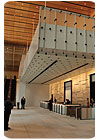
Photo courtesy of Cook + Fox Architects
Kashmir White granite - supplied by Hindustan Granites, Inc. of Hauppauge, NY - was employed as flooring throughout the public spaces of the new Bank of America Tower in Manhattan.
Kashmir White granite - supplied by Hindustan Granites, Inc. of Hauppauge, NY - was employed as flooring throughout the public spaces of the new Bank of America Tower in Manhattan.
The Bank of America Tower at One Bryant Park is among the newest high-rises to join Manhattan’s world-famous skyline. The 55-story building, which encompasses a total of 2.2 million square feet, was designed by Cook + Fox Architects, LLP of New York, NY, with the objective of becoming the most environmentally responsible high-rise office building in the U.S. Contributing to the building’s distinctive stature is an extensive amount of stone from India - supplied by Hindustan Granites Inc. of Hauppauge, NY - which was employed throughout the building’s public spaces as well as for exterior paving.
According to a statement released by Cook + Fox Architects, the design intent was “inspired by the famed New York Crystal Palace, the first light metal frame building in America, erected in Bryant Park in 1953, along with cultural influences from New York City’s classic skyscrapers. The design traces the history of the palace, while representing the city’s optimism of its future through the suggestion of the architectural forms.”
Moreover, the new Bank of America Tower embraces and is specific to its unique urban context, according to the design team. “Verticality of the building’s massing, spiraling up to the tip of the tallest spire, responds to the Midtown Manhattan skyline, while the configuration of the base addresses the local pedestrian and transportation thoroughfares,” stated the firm.
Inside the building, one of the key components of the design is Kashmir White granite. The material, which features a flamed finish, was quarried in the state of Tamil Nadu, Southern India, and then fabricated at Hindustan Granites’ processing plant.
In total, more than 40,000 square feet of Kashmir White granite was utilized in the building’s design. For interior publics spaces, including the main lobby, second floor lobby and elevators, the floor tile sizes primarily consist of 60 x 30 and 70 x 30 inches with a thickness of 1 ¼ inches, while the outside paving has a thickness of 2 inches.
“It took about eight months to fabricate everything,” said Prakash Doddahosahalli of Hindustan Granites. “This is inclusive of preparation and approval of the mock-up at the factory.”
Doddahosahalli explained that two project architects from Cook + Fox, an architect and a Vice President from Bank of America and a Vice President from Wilkstone, LLC, the stone installer for the job, visited the company’s factory in India to approve the mock-up. “Quality control for color and size was of a very high standard,” he said.
According to Joe Petti of Wilkstone, a traditional mortar bed was used to lay the tile. Depending on the area, the thickness of the mortar bed varied from a minimum of 3 inches to a maximum of 5 inches. All of the granite floor tiles were dry laid out at Wilkstone’s facility in Paterson prior to installation, so that they could be viewed and approved, said the installer, adding that the floor tiles covered approximately 25,000 square feet of space.
Hindustan Granites also supplied 3,000 square feet of Crystallized Glass, which was employed at the escalators. “Crystallized Glass is [created through] a very sophisticated technique of sintering selected minerals and fusing the sintered crystals together through intense high temperature,” explained Doddahosahalli. “This material is identical to pure White Thassos [marble], but unlike Thassos, its hardness is closer to granite.”
The interior design of the Bank of America Tower also features unique feature walls in the main lobby that are made of varying-sized pieces of Jerusalem Gray limestone. Some pieces are set back, while others are raised - adding texture and depth to the space.
“Each stone is individually supported with steel clips,” Petti said of the limestone wall cladding, adding that the range of thickness included 2, 1 ½ and 1 ¼ inches. “The most challenging part was the amount of pieces and the amount of sizes.”
A total of 9,000 square feet of Jerusalem Gray limestone was used for the project. “We brought the slabs in raw and fabricated the pieces in our shop in Paterson,” explained Petti. “All of the scrap was sent Upstate [New York] to be recycled for green building block.”
According to the installer, six to 12 workers from Wilkstone were on site at any given time. It took approximately four months to complete the stone installation.
The new Bank of America Tower was designed and built with the environment in mind. According to Cook + Fox Architects, a goal of the project was to be the “most environmentally responsible high-rise office building in the U.S., focusing on sustainable sites, water efficiency, indoor environmental quality, and energy and atmosphere.” The intent was also for it to be the first high-rise to strive for the U.S. Green Building Council’s Leadership in Energy & Environment Design (LEED) “Platinum” designation.
